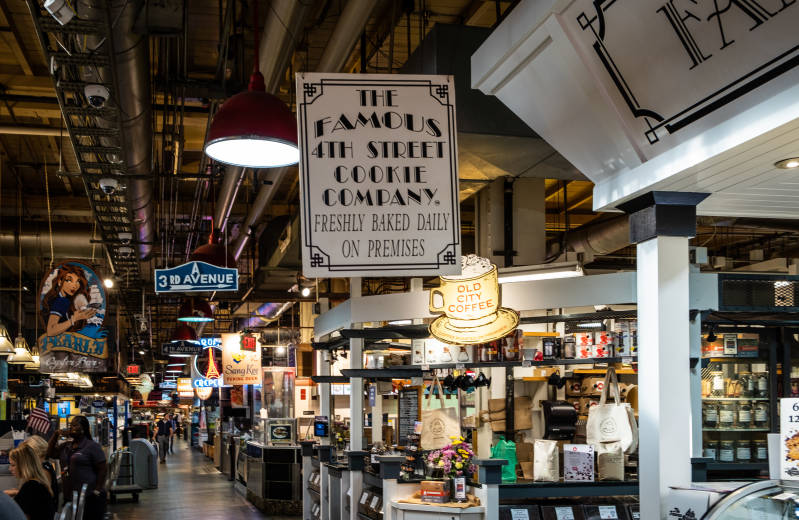
Philadelphia is a city with many highlights. We spent 2 full days in the city, just enough to capture some of them. We missed out on Fairmount park and some of the fine art museums!
The city is known for its history. For example The Declaration of Independence, Liberty bell and Indepence Hall, to name a view. It's a big city but the main sights are within walking distance from each other. If you don't feel like walking, there is a subway you can use.
City hall was once the tallest building in the city, sir William Penn on top of the roof, overlooking the area. Nowadays the beautiful Second Empire style building is surrounded by modern architecture.
The old city
The old city is the part of town where all the important historical stuff is to be found. A beautiful visitor center provides you with detailed information of this area. It actually is a National historical park, being taken care of by the National Park services.

Liberty bell
Our first stop was the Liberty bell. I already saw a replica of this bell down in Disneyworld many times before, so to be able to finally see the real one was great! The bell marks liberty in many different ways and in many different points in time. From US independance until equal womens right and the right to vote. The bell even travelled the country and many people paid respect to it.
Independence hall
Independence Hall is the building where both the United States Declaration of Independence and the United States Constitution were debated and adopted. It is now the centerpiece of the Independence National Historical Park in Philadelphia, Pennsylvania.
source: Indepence hall - Wikipedia

Reading terminal
I wish I could just write a post on Reading terminal, but I don’t know enough to actually be able to do this. Reading terminal is just a stop during our visit to Philadelphia, but the building is impressive, even more because a close friend worked here many years ago. Through her eyes I could see the trains arriving, passengers hurrying through the terminal and employees arriving to work on the office side. The terminal turned into part of the convention center and the offices are now turned into hotelrooms. Inside the building you are still able to find some history about the railway company.


Source: Reading terminal
Reading terminal market
What didn’t change is Reading terminal market. The market is located on the ground floor of the terminal building and one of the top sights in Philadelhia. Inside you will find over 75 delicatessen food stalls and some dining possibilities. It’s a great foto location!!


Elfreth's alley
Elfreth's alley is a historic street in Philadelphia, dating back to 1702. As of 2012, there are 32 houses on the street, which were built between 1728 and 1836. The alley is a tourist attraction and a rare surviving example of 18th-century working-class housing stock.
source: Elfreth's Alley - Wikipedia

Italian Market
The Italian Market, frequently referred to simply as 9th Street, has its origins as a marketplace in the later 19th and early 20th centuries. The area, outside the original boundaries of William Penn's planned city, was an area for immigrants to settle in. Italian immigrants began to move into the area around 1884. Shops along 9th Street opened up shortly afterward to cater to the new Italian community and have remained in the area to this day, with many of the present vendors tracing the founding of their businesses back to the first decade of the 20th century.
The name "Italian Market" came about in the mid-1970s as supermarket chains began to move to the area. During this time, many other ethnicities abandoned the Market, and the Ninth Street Market was left with a predominantly Italian population that continued to buy, sell, and operate in the market.
Source: Italian Market, Philadelphia - Wikipedia


Philadelphia's Magical Gardens
Philadelphia’s Magic Gardens (PMG) is an immersive mixed media art environment that is completely covered with mosaics. The creator, Isaiah Zagar, used handmade tiles, bottles, bicycle wheels, mirror, and international folk art to chronicle his life and influences. Zagar has devoted himself to beautifying the South Street neighborhood since the late 1960s, when he moved to the area with his wife, Julia. The couple helped spur the revitalization of the area by renovating derelict buildings and adding colorful mosaics on both private and public walls. The Zagars, teamed with other artists and activists, transformed the neighborhood into a prosperous artistic haven and successfully led protests against the addition of a new highway that would have eliminated South Street. This period of artistic rebirth was coined the “South Street Renaissance.” After the street was saved, Zagar continued creating mosaic murals, resulting in hundreds of public artworks over the next five decades.
source: phillysmagicalgardens.org


30th Street Station
30th Street Station was build between 1929 - 1934 and one of the first large stations build for electric locomotives. The station is designed in a monumental Classical style and after completion it became the headquarters of the Pennsylvania Railroad (PPR). The interieur decoration is an Art Deco style, popular in early part of the twentieth century. The 40-foot high sculpture, "Angel of Resurrection," at the east entrance is a PPR memorial to its World War II employees who served and died in the conflict.



Add comment
Comments